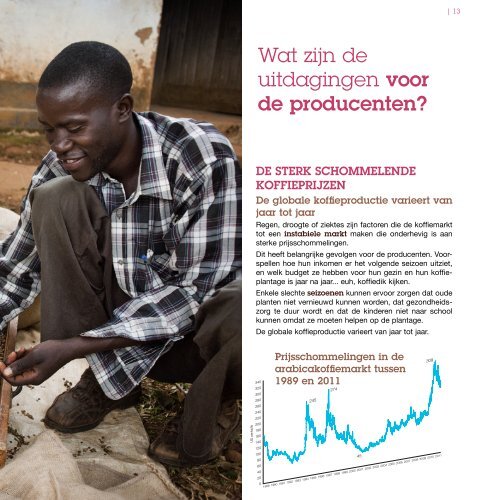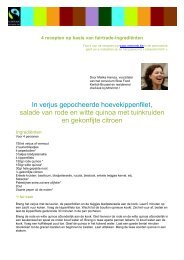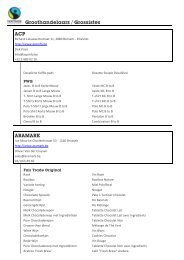Brochure: koffie & Fairtrade. - Max Havelaar
Brochure: koffie & Fairtrade. - Max Havelaar
Brochure: koffie & Fairtrade. - Max Havelaar
You also want an ePaper? Increase the reach of your titles
YUMPU automatically turns print PDFs into web optimized ePapers that Google loves.
Wat zijn de<br />
uitdagingen voor<br />
de producenten?<br />
| 13<br />
de Sterk SCHoMMeLeNde<br />
<strong>koffie</strong>PriJZeN<br />
de globale <strong>koffie</strong>productie varieert van<br />
jaar tot jaar<br />
Regen, droogte of ziektes zijn factoren die de <strong>koffie</strong>markt<br />
tot een instabiele markt maken die onderhevig is aan<br />
sterke prijsschommelingen.<br />
Dit heeft belangrijke gevolgen voor de producenten. Voorspellen<br />
hoe hun inkomen er het volgende seizoen uitziet,<br />
en welk budget ze hebben voor hun gezin en hun <strong>koffie</strong>plantage<br />
is jaar na jaar... euh, <strong>koffie</strong>dik kijken.<br />
Enkele slechte seizoenen kunnen ervoor zorgen dat oude<br />
planten niet vernieuwd kunnen worden, dat gezondheidszorg<br />
te duur wordt en dat de kinderen niet naar school<br />
kunnen omdat ze moeten helpen op de plantage.<br />
De globale <strong>koffie</strong>productie varieert van jaar tot jaar.<br />
2.2. Coffee prices<br />
Price volatility<br />
Global coffee production varies from year to year according to weather conditions, disease and other factors,<br />
resulting in a coffee market that is inherently unstable and characterised by wide fluctuations in price.<br />
This price volatility has significant consequences for those who depend on coffee for their livelihood, making it<br />
difficult for growers to predict their income for the coming season and budget for their household and farming<br />
needs. When prices are low farmers have neither the incentive nor resources to invest in good maintenance of the<br />
farms by applying fertilisers and pesticides or replacing old trees. When prices fall below the costs of production,<br />
farmers struggle to put adequate food on the table and pay medical bills and school fees – a major reason for<br />
children being taken out of school to contribute to the family income by working on the farm or in the informal<br />
sector. In recent years the price of arabica has swung from a 30-year low of 45 cents a pound in 2001 to a 34-yea<br />
high of almost 309 cents in 2011 (Figure 5). Similarly, robusta crashed to 17 cents a pound in 2001 before climbin<br />
to 120 cents in 2011 (Figure 6).<br />
Prijsschommelingen in de<br />
arabica<strong>koffie</strong>markt tussen<br />
1989 en 2011<br />
Figure 5: The arabica coffee market 1989-2011<br />
US cents/lb<br />
340<br />
320<br />
300<br />
280<br />
260<br />
240<br />
220<br />
200<br />
180<br />
160<br />
140<br />
120<br />
100<br />
80<br />
60<br />
40<br />
20<br />
0<br />
245<br />
274<br />
1989 1990 1991 1992 1993 1994 1995 1996 1997 1998 1999 2000 2001 2002 2003 2004 2005 2006 2007 2008 2009 2010 2011<br />
45<br />
309




